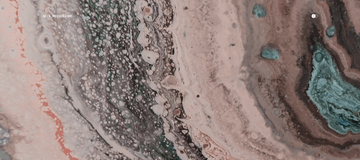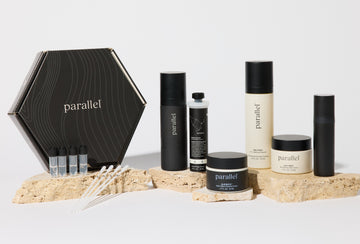When I was growing up, oil-based products were warned against. Using oils, while hydrating when I had severely dry skin, could sometimes make my skin worse. It blocked my pores and often made me break out. But today, through clean formulations and more scientific data on skincare ingredients, we now know there are a lot of amazing oils on the market that can do wonders – of course, for the right condition and skin (microbiome) type.
So today, let’s break down a few key oils that work for or against your skin.
Sebum, the balance that can make or break your skin
There are tiny sebaceous glands in our bodies. These glands secrete an oil known as sebum. A moderate amount of sebum is normal and healthy. Sebum’s purpose is to moisturize and protect your skin barrier. In addition, it supports your skin microbiome, serving as food for certain types of bacteria, known as C. acnes. Now, there are healthy and unhealthy strains of C. acnes. Most people in the western world who have generally healthy skin will have good C. acnes strains living in their skin microbiome. However, unhealthy C. acnes strains are associated with acne vulgaris. Overproduction of sebum can block skin follicles and enable bacteria (particularly the unhealthy strains) to multiply, causing inflammation. This leads to an increasing acne problem.
Comedogenic oils = stay away (in general)
Comedogenic means “pore-clogging.” Comedogenic ingredients are known to cause inflammation, blackheads, whiteheads, and pimples. Parallel’s Chief Science Officer Dr. Nathan Brown says, “If you have a very healthy skin microbiome that is quite resilient, a brush with oils higher on the comedogenic spectrum likely won’t cause side effects; however, for many who are acne-prone or have sensitive skin, you should stick with oils and other ingredients that are non-comedogenic.”
What oils are comedogenic and should be avoided if you have blemish-prone skin? The list is actually quite long. But some common skincare ingredients that are comedogenic are cocoa butter, coconut oil, mineral oil, palm oil, and wheat germ oil. Oils like these are high on the comedogenic scale and should only be used if you don’t have acne-prone skin.
Face Oils for Different Skin Types
For the right skin type and condition, facial oils can be helpful in two main ways:
1. Oils can penetrate deep into the skin layers and even between skin cells; using an effective oil can really help repair the skin at the cellular level
2. Oils have the ability to also maintain presence on the skin surface, thereby locking in moisture and increasing hydration
Following are some of the facial oils scientifically proven to help rejuvenate your skin and are generally non-comedogenic or low on the comedogenic scale:
Abyssinian Seed Oil
Abyssinian oil is abundant in fatty acids, known to have anti-inflammatory effects and aid in skin regeneration. Additionally, this oil is known to prevent fine lines and revive dry skin by helping you shed dead skin, making your face look more youthful and radiant.
Argan Oil
Argan oil is most famous for its moisturizing properties, thus it works great for those who are experiencing dry skin. The prominent fatty acid in argan oil is oleic acid and linoleic acid. It helps in retaining moisture in the skin and restoring its barrier.

Blueberry Seed Oil
Like abyssinian seed oil and argan oil, unrefined blueberry seed oil is also rich in fatty acids. It helps the skin diminish the appearance of wrinkles, leaving it plump and radiant. A good quality blueberry seed oil is often light and absorbs quickly into skin – perfect for most skin types, especially acne-prone and sensitive skin.
Goji Berry Seed Oil
Goji Berry Seed Oil is known to support the reduction of wrinkles, enhance skin elasticity and even out skin tone. Exceptionally high in essential fatty acids, especially linoleic acid, this oil protects and repairs the skin by stimulating intracellular oxygenation. Like blueberry seed oil, goji berry seed oil is extremely light and absorbed easily, making it ideal for use around the eye-contour area, where other products can often promote the creation of milia, generally white little bumps that appear on the eyelids and temples.
Squalane Oil
Squalane mimics your skin’s natural oils, so it hydrates and smoothes your skin texture. This oil is high in omega-2 fatty acids, which fights skin damage and free radicals, helping with anti-aging efforts. Regular use can detoxify and also boost collagen production, resulting in plumper looking skin.
These are just a few oils that are generally non-comedogenic (therefore, generally skin-microbiome friendly) and highly effective in improving skin health and appearance by providing detoxification, preventing or reducing the appearance of fine lines, and supporting hydration.
Ultimately, your skin is unique, so we expect that some oils will be better suited to your skin microbiome type than others. If you give any of these non-comedogenic oils a try, let us know how it goes! hello@parallelhealth.io
—------------
Want to discover your skin microbiome? Sign up here to share about your skin journey and be kept apprised of skin microbiome research opportunities and personalized products.
About Parallel
A parallel world lives amongst us: the microbial world. This world impacts not only our lifespan, but also our healthspan.
Our mission is to empower people with real science to make meaningful decisions to improve their healthspan.
Parallel is a microbial diagnostics and next-level skincare company that aims to revolutionize skin health by providing deep insight and true personalization, through best-in-class testing and targeted, clean microbial formulations.
Boucetta, K. Q., et al. “The Effect of Dietary And/or Cosmetic Argan Oil on Postmenopausal Skin Elasticity.” Clinical Interventions in Aging, vol. 10, Clin Interv Aging, Jan. 2015, doi:10.2147/CIA.S71684.
Li, X., et al. “A Review of the Role of Sebum in the Mechanism of Acne Pathogenesis.” Journal of Cosmetic Dermatology, vol. 16, no. 2, J Cosmet Dermatol, June 2017, doi:10.1111/jocd.12345.
Pasparakis M., Haase I., Nestle F.O. Mechanisms regulating skin immunity and inflammation. Nat. Rev. Immunol. 2014;14:289–301. doi: 10.1038/nri3646.
França K., Lotti T., editors. Advances in Integrative Dermatology. Wiley; Hoboken, NJ, USA: 2019.
Riley D.S., Anderson R., Blair J.C., Crouch S., Meeker W., Shannon S., Sudak N., Thornton L., Low Dog T. The academy of integrative health and medicine and the evolution of integrative medicine practice, education, and fellowships. Integr Med. Clin. J. 2016;15:38–41.
Bonesi M., Loizzo M.R., Provenzano E., Menichini F., Tundis R. Anti-psoriasis agents from natural plant sources. Curr. Med. Chem. 2016;23:1250–1267. doi: 10.2174/0929867323666160321121819.
Radice M., Manfredini S., Ziosi P., Dissette V., Buso P., Fallacara A., Vertuani S. Herbal extracts, lichens and biomolecules as natural photo-protection alternatives to synthetic UV filters. A systematic review. Fitoterapia. 2016;114:144–162. doi: 10.1016/j.fitote.2016.09.003.




























